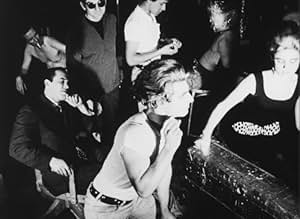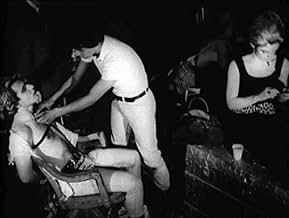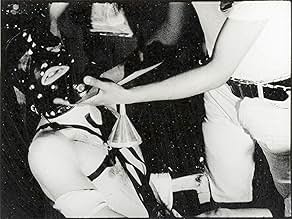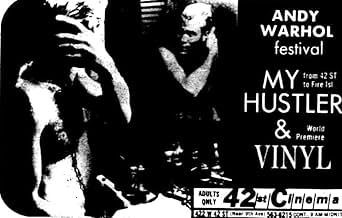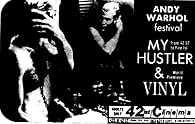Vinyl
- 1965
- 1h 10m
IMDb RATING
4.2/10
1.2K
YOUR RATING
Warhol's strange interpretation of "A Clockwork Orange." Includes Gerard dancing to the Martha and the Vandellas classic "Nowhere to Run" and being tortured by professional sadists.Warhol's strange interpretation of "A Clockwork Orange." Includes Gerard dancing to the Martha and the Vandellas classic "Nowhere to Run" and being tortured by professional sadists.Warhol's strange interpretation of "A Clockwork Orange." Includes Gerard dancing to the Martha and the Vandellas classic "Nowhere to Run" and being tortured by professional sadists.
- Director
- Writers
- All cast & crew
- Production, box office & more at IMDbPro
Featured reviews
Man, that Andy Warhol must have really not wanted to spend any money on his movies. I can't even really call this a movie, since it follows no story, and no real directing and acting.
Watching this was an horrible experience and it actually felt like a torment. What this movie basically is are Andy Warhol's usual groupies sitting in a corner with a camera pointed at them, doing either weird stuff or absolutely nothing. Appearantly this was Andy Warhol's version and interpretation of Anthony Burgess' 'A Clockwork Orange' but the movie doesn't even follow its story. It's as if Warhol one day picked up a camera and said 'let's shoot something, I'm bored!'. I'm sure they all had good fun doing weird stuff in front of the camera but why bother us with it? The movie doesn't make a point about anything. It doesn't provoke and it's not even artistically a well shot movie.
The camera doesn't move at all, not even when the actors accidentally are out of frame. Also no cuts were made and I'm pretty sure they never rehearsed or prearranged anything. Everything was shot on the spot and things were made up as it moved along. As a result of this the movie just goes on and on, even when absolutely nothing is happening. I seriously had to fast-forward through most of this movie or else I would had most likely never been able to finish it. It was that pointless, annoying and just plain awful to watch.
Funny thing is that the 'actors' themselves also didn't had a clue what they were doing. You can constantly hear voices off cam whispering their lines and saying what they should do next. Besides, they are simply horrible at what they are doing. Edie Sedgwick constantly had a hard time not laughing or looking at the people behind the camera's. Highly annoying and distracting.
Completely unwatchable, even from an artistic viewpoint.
1/10
http://bobafett1138.blogspot.com/
Watching this was an horrible experience and it actually felt like a torment. What this movie basically is are Andy Warhol's usual groupies sitting in a corner with a camera pointed at them, doing either weird stuff or absolutely nothing. Appearantly this was Andy Warhol's version and interpretation of Anthony Burgess' 'A Clockwork Orange' but the movie doesn't even follow its story. It's as if Warhol one day picked up a camera and said 'let's shoot something, I'm bored!'. I'm sure they all had good fun doing weird stuff in front of the camera but why bother us with it? The movie doesn't make a point about anything. It doesn't provoke and it's not even artistically a well shot movie.
The camera doesn't move at all, not even when the actors accidentally are out of frame. Also no cuts were made and I'm pretty sure they never rehearsed or prearranged anything. Everything was shot on the spot and things were made up as it moved along. As a result of this the movie just goes on and on, even when absolutely nothing is happening. I seriously had to fast-forward through most of this movie or else I would had most likely never been able to finish it. It was that pointless, annoying and just plain awful to watch.
Funny thing is that the 'actors' themselves also didn't had a clue what they were doing. You can constantly hear voices off cam whispering their lines and saying what they should do next. Besides, they are simply horrible at what they are doing. Edie Sedgwick constantly had a hard time not laughing or looking at the people behind the camera's. Highly annoying and distracting.
Completely unwatchable, even from an artistic viewpoint.
1/10
http://bobafett1138.blogspot.com/
Warhol's adaptation (for lack of a more shambling word) of Anthony Burgess' A CLOCKWORK ORANGE begins with a giant closeup of the glowering droog antihero, then moves backward to reveal him narcissistically preening while a crowd of poshy socialites sits blithely by. If this sounds familiar, it's because it's the same opening Stanley Kubrick designed for his version of the book--except that Warhol, working on a sub-Z budget, could only zoom backward, not track.
VINYL is staged in what seems to be a corner of Andy's Factory loft, where a knot of S&M kidnappers, languid dilettantes, plainclothesmen and JD's act out Burgess' fable of a thug's "cure" through mind control. The moralizing of Burgess' novel gets instantly burned away in the wake of a kooky combination of elegant minimalist mise-en-scene, rough-trade heavy breathing, and the usual Warholian giggling at seemingly blithe freaks and damaged goods
Some of the picture lags under the burden of Ronald Tavel's clunky sixties-off-Broadway writing, but the first sequence is sheer amazement--climaxing with the droog Gerard Malanga's motto-delivering monologue (a pinnacle among Warhol is-this-supposed-to-be-bad? scenes) and his nutty chicken dance to Martha and the Vandellas' "Nowhere to Hide"--played all the way through, twice. (The start-up of rendition #2 gets the movie's biggest laugh.)
As always in Warhol, the stasis of the image gives the picture the feeling of a window onto eternity. And the combination of extreme glamour and fox-in-the-henhouse cruelty, framed in compositions that recall heads in a vise, suggests the excitement this work must have had for an ambitious young Bavarian actor-playwright named Rainer Werner Fassbinder.
VINYL is staged in what seems to be a corner of Andy's Factory loft, where a knot of S&M kidnappers, languid dilettantes, plainclothesmen and JD's act out Burgess' fable of a thug's "cure" through mind control. The moralizing of Burgess' novel gets instantly burned away in the wake of a kooky combination of elegant minimalist mise-en-scene, rough-trade heavy breathing, and the usual Warholian giggling at seemingly blithe freaks and damaged goods
Some of the picture lags under the burden of Ronald Tavel's clunky sixties-off-Broadway writing, but the first sequence is sheer amazement--climaxing with the droog Gerard Malanga's motto-delivering monologue (a pinnacle among Warhol is-this-supposed-to-be-bad? scenes) and his nutty chicken dance to Martha and the Vandellas' "Nowhere to Hide"--played all the way through, twice. (The start-up of rendition #2 gets the movie's biggest laugh.)
As always in Warhol, the stasis of the image gives the picture the feeling of a window onto eternity. And the combination of extreme glamour and fox-in-the-henhouse cruelty, framed in compositions that recall heads in a vise, suggests the excitement this work must have had for an ambitious young Bavarian actor-playwright named Rainer Werner Fassbinder.
There are bad movies, and there are BAD movies. After 70 agonizing minutes, I realized this is genuinely in the running for worst movie I've ever seen. I can't think of a single redeeming feature, just the bad ones, from the wooden acting, truly unimpressive cinematography and staging, (I'd complain about the editing, but there is none), etc.
Best to just read the book and watch the Kubrick movie.
This footage is little more than a filmed rehearsal in a corner of a warehouse. Warhol demonstrates the 'less is more' mantra to an unplumbed basement of embarrassment. This vision of Warhol's really has nothing to do with the medium of film, and all that is learned is that he was very spoiled to have the resources in order to make this, for there are bound to be more important artists and concepts (and even adaptations) that went un-filmed in this era of early experimentation.
Warhol fills a stage with the cast, and we can only sympathize with them, for their talents are criminally obstructed by the moronic limitations imposed upon them. With presumably only the source text (a novel) to go by (for who would argue that any useful screenplay was written?), the actors go about filling out the bare guidelines of the inappropriately treated material. Warhol, like a spoiled child, asks so much of his cast while giving so little; and beyond that, he almost seems to obstruct or minimize the source material.
Given this, the performers do what they can when they can, and without them, this film would have nothing to give. Warhol's demonstrated contempt for cinema acts as a saboteur; the performers at the mercy of his nonconstructive (mark it, not 'de-constructive') approach, and we are forced to watch them feel for cues, lines and staging directions. Shamefully, it is left for them to stick their necks out. Warhol, like a selfish undergraduate, seems to hide childishly behind the camera – the very last place any true artist would escape to.
Carillo, Latrae and particularly Malanga are victorious even with these enormous obstructions (not, I argue, because of them). Their lines are delivered fairly robotic-like and sporadically; a rhythm is established because of this, but it abandoned well into the 'second-reel'. Here we are treated to some off-camera sadism, while even the most hardened of extras (E. Sedgewick for example) remain distant, unmoved and as bored as anyone else involved: actors and audience alike. When the cast display indifference and the director promotes his carelessness, we are only left with spectacle. Even there, 'Vinyl' has little to give. The highlight of the film (or at least the most memorable set piece) is that of Malanga dancing to 'Nowhere to Run'.
Twice.
Following this there is a smattering of whipping, strapping, beating and struggling. The film then descends into further unscripted stumbling and ramblings. Most of it stays in frame.
I can't see what Warhol gave us with this film. The narrative is lost, the actors are maltreated, and the production values do more harm than good. Warhol fails on virtually all grounds here – the real kudos needs to go to the performers. This film is a very selfish one, spawned from a selfish, lazy director.
Warhol fills a stage with the cast, and we can only sympathize with them, for their talents are criminally obstructed by the moronic limitations imposed upon them. With presumably only the source text (a novel) to go by (for who would argue that any useful screenplay was written?), the actors go about filling out the bare guidelines of the inappropriately treated material. Warhol, like a spoiled child, asks so much of his cast while giving so little; and beyond that, he almost seems to obstruct or minimize the source material.
Given this, the performers do what they can when they can, and without them, this film would have nothing to give. Warhol's demonstrated contempt for cinema acts as a saboteur; the performers at the mercy of his nonconstructive (mark it, not 'de-constructive') approach, and we are forced to watch them feel for cues, lines and staging directions. Shamefully, it is left for them to stick their necks out. Warhol, like a selfish undergraduate, seems to hide childishly behind the camera – the very last place any true artist would escape to.
Carillo, Latrae and particularly Malanga are victorious even with these enormous obstructions (not, I argue, because of them). Their lines are delivered fairly robotic-like and sporadically; a rhythm is established because of this, but it abandoned well into the 'second-reel'. Here we are treated to some off-camera sadism, while even the most hardened of extras (E. Sedgewick for example) remain distant, unmoved and as bored as anyone else involved: actors and audience alike. When the cast display indifference and the director promotes his carelessness, we are only left with spectacle. Even there, 'Vinyl' has little to give. The highlight of the film (or at least the most memorable set piece) is that of Malanga dancing to 'Nowhere to Run'.
Twice.
Following this there is a smattering of whipping, strapping, beating and struggling. The film then descends into further unscripted stumbling and ramblings. Most of it stays in frame.
I can't see what Warhol gave us with this film. The narrative is lost, the actors are maltreated, and the production values do more harm than good. Warhol fails on virtually all grounds here – the real kudos needs to go to the performers. This film is a very selfish one, spawned from a selfish, lazy director.
"Vinyl" is so bad that for a moment I almost enjoyed it when I realized what's his creator was intending to do. I almost feel bad in writing a negative review about it because I understood what Andy Warhol made here. The problem is the experience's result on me, how I felt until I reach a positive enlightenment about what this is all about. Seeing the whole picture as a whole it didn't satisfied me to look at it in a good way.
Slowing down this confused thoughts, let me go from the beginning now. "Vinyl" is a free adaptation of Anthony Burgess revolutionary work "A Clockwork Orange". You read right. Kubrick wasn't the first to play with this material. Forget about Alex DeLarge, his rebellion, his mates and the violence and all. All we see here is the part of his "treatment" to become a good person and get nauseated with the things at once he used to love. In its one hour and so, "Vinyl" goes to show a young man being tortured by an eccentric group of people through some strange methods such as forced to hear loud music (among the songs there's "Nowhere to Run" - Martha Reeves and the Vandellas, OK, this is not really torture, that is such an uplifting and great song. Might work to the youngsters of today who can only listen to noise they call music), spanking, suffocation and other things. For the most part this young man will suffer physical and verbal abuse to finally reach his "cure". Yes, the characters speak but you can barely understand what they're saying.
My enlightenment came after a long while and so many thoughts trying to figure out what's the movie's point. Warhol wanted that we feel all the pain, the misery, the annoyance his main character gets from those people. He succeed in that! We feel bored, hurt to a certain extent horrified by all the punishment the man gets (even if the camera is still and we don't have close ups to see what's happening to him in the background but there's his scream to be heard), we feel anguished, tormented, wanting for all that (the movie, the music and the beatings) to stop. The whole situation is like a damaged vinyl, it keeps going on and on repeating the same part until someone turns the player off, or change the record. Brilliant, isn't it? I got it!
Here comes the problem in enduring such thing. It sounded pretentious and it didn't work. Warhol is cheating on us here. David Lynch can disturb us, present his shocking show, make it difficult to us but in the end we feel that we've got something there even if we didn't solve the whole charade. It's easier to enjoy and obtain something from his works. Can't say the same about the pop art master with this particular film that is too long with its allegedly message, it's exhausting and often you'll be closing your eyes, falling asleep but amazingly hearing all what's going on. It's funny that I made the comparison between Lynch and Warhol because it reminds of an overreacting criticism of a reviewer who said that Lynch treated badly his actors in "Blue Velvet", he tortured them by making them perform strange things. I don't see it that way in that movie, but here I do. There's no stunt doubles here, everything looks and sounds quite real (it might have been some technique, I don't know) every time the young actor gets spanked, bound to a chair, screaming and moaning. He was mistreated in so many ways to one can wonder how much money did he got for all of this (you can't get much of an indie project).
Like I said before, I feel a little bad for disliking this. It's a bad movie for what it tries to make to us but it's not so lame like many disastrous Hollywood flicks that might had a good intention that got perverted on the way. Highpoint of this is listening to "Nowhere to Run" twice with the actors performing some crazy dance movements. Gladly, such scene appears when I thought this could have been a great movie, right in the first minutes. An experience for the courageous at heart and mind who can spare an hour of his life without getting anything in trade. I watched the whole thing, didn't like it but don't regret nothing. 2/10
Slowing down this confused thoughts, let me go from the beginning now. "Vinyl" is a free adaptation of Anthony Burgess revolutionary work "A Clockwork Orange". You read right. Kubrick wasn't the first to play with this material. Forget about Alex DeLarge, his rebellion, his mates and the violence and all. All we see here is the part of his "treatment" to become a good person and get nauseated with the things at once he used to love. In its one hour and so, "Vinyl" goes to show a young man being tortured by an eccentric group of people through some strange methods such as forced to hear loud music (among the songs there's "Nowhere to Run" - Martha Reeves and the Vandellas, OK, this is not really torture, that is such an uplifting and great song. Might work to the youngsters of today who can only listen to noise they call music), spanking, suffocation and other things. For the most part this young man will suffer physical and verbal abuse to finally reach his "cure". Yes, the characters speak but you can barely understand what they're saying.
My enlightenment came after a long while and so many thoughts trying to figure out what's the movie's point. Warhol wanted that we feel all the pain, the misery, the annoyance his main character gets from those people. He succeed in that! We feel bored, hurt to a certain extent horrified by all the punishment the man gets (even if the camera is still and we don't have close ups to see what's happening to him in the background but there's his scream to be heard), we feel anguished, tormented, wanting for all that (the movie, the music and the beatings) to stop. The whole situation is like a damaged vinyl, it keeps going on and on repeating the same part until someone turns the player off, or change the record. Brilliant, isn't it? I got it!
Here comes the problem in enduring such thing. It sounded pretentious and it didn't work. Warhol is cheating on us here. David Lynch can disturb us, present his shocking show, make it difficult to us but in the end we feel that we've got something there even if we didn't solve the whole charade. It's easier to enjoy and obtain something from his works. Can't say the same about the pop art master with this particular film that is too long with its allegedly message, it's exhausting and often you'll be closing your eyes, falling asleep but amazingly hearing all what's going on. It's funny that I made the comparison between Lynch and Warhol because it reminds of an overreacting criticism of a reviewer who said that Lynch treated badly his actors in "Blue Velvet", he tortured them by making them perform strange things. I don't see it that way in that movie, but here I do. There's no stunt doubles here, everything looks and sounds quite real (it might have been some technique, I don't know) every time the young actor gets spanked, bound to a chair, screaming and moaning. He was mistreated in so many ways to one can wonder how much money did he got for all of this (you can't get much of an indie project).
Like I said before, I feel a little bad for disliking this. It's a bad movie for what it tries to make to us but it's not so lame like many disastrous Hollywood flicks that might had a good intention that got perverted on the way. Highpoint of this is listening to "Nowhere to Run" twice with the actors performing some crazy dance movements. Gladly, such scene appears when I thought this could have been a great movie, right in the first minutes. An experience for the courageous at heart and mind who can spare an hour of his life without getting anything in trade. I watched the whole thing, didn't like it but don't regret nothing. 2/10
Did you know
- TriviaIncluded among the "1001 Movies You Must See Before You Die", edited by Steven Schneider.
- ConnectionsFeatured in Exploding Plastic Inevitable (1967)
- SoundtracksNowhere to Run
Written by Lamont Dozier, Brian Holland and Eddie Holland
Performed by Martha & The Vandellas
- How long is Vinyl?Powered by Alexa
Details
- Runtime1 hour 10 minutes
- Color
- Sound mix
Contribute to this page
Suggest an edit or add missing content



